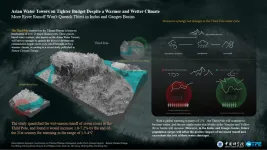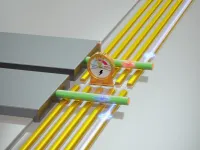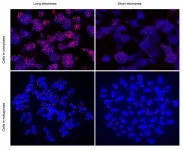(Press-News.org) CAMBRIDGE, MA -- Engineers at MIT and Imperial College London have developed a new way to generate tough, functional materials using a mixture of bacteria and yeast similar to the "kombucha mother" used to ferment tea.
Using this mixture, also called a SCOBY (symbiotic culture of bacteria and yeast), the researchers were able to produce cellulose embedded with enzymes that can perform a variety of functions, such as sensing environmental pollutants. They also showed that they could incorporate yeast directly into the material, creating "living materials" that could be used to purify water or to make "smart" packaging materials that can detect damage.
"We foresee a future where diverse materials could be grown at home or in local production facilities, using biology rather than resource-intensive centralized manufacturing," says Timothy Lu, an MIT associate professor of electrical engineering and computer science and of biological engineering.
Lu and Tom Ellis, a professor of bioengineering at Imperial College London, are the senior authors of the paper, which appears today in Nature Materials. The paper's lead authors are MIT graduate student Tzu-Chieh Tang and Cambridge University postdoc Charlie Gilbert.
Division of labor
Several years ago, Lu's lab developed a way to use E. coli to generate biofilms embedded with materials such as gold nanowires. However, those films are very small and thin, making them difficult to use in most large-scale applications. In the new study, the researchers set out to find a way to use microbes to generate larger quantities of more substantial materials.
They thought of creating a microbe population similar to a kombucha mother, which is a mixture of certain types of bacteria and yeast. These fermentation factories, which usually contain one species of bacteria and one or more yeast species, produce ethanol, cellulose, and acetic acid, which gives kombucha tea its distinctive flavor.
Most of the wild yeast strains used for fermentation are difficult to genetically modify, so the researchers replaced them with a strain of laboratory yeast called Saccharomyces cerevisiae. They combined the yeast with a type of bacteria called Komagataeibacter rhaeticus, which their collaborators at Imperial College London had previously isolated from a kombucha mother. This species can produce large quantities of cellulose.
Because the researchers used a laboratory strain of yeast, they could engineer the cells to do any of the things that lab yeast can do -- for example, producing enzymes that glow in the dark, or sensing pollutants in the environment. The yeast can also be programmed so that they can break down pollutants after detecting them.
Meanwhile, the bacteria in the culture produce large-scale quantities of tough cellulose to serve as a scaffold. The researchers designed their system so that they can control whether the yeast themselves, or just the enzymes that they produce, are incorporated into the cellulose structure. It takes only a few days to grow the material, and if left long enough, it can thicken to occupy a space as large as a bathtub.
"We think this is a good system that is very cheap and very easy to make in very large quantities," Tang says. "It's at least a thousand times more material than the E.coli system."
Just add tea
To demonstrate the potential of their microbe culture, which they call "Syn-SCOBY," the researchers created a material incorporating yeast that senses estradiol, which is sometimes found as an environmental pollutant. In another version, they used a strain of yeast that produces a glowing protein called luciferase when exposed to blue light. These yeasts could be swapped out for other strains that detect other pollutants, metals, or pathogens.
The culture can be grown in normal yeast culture medium, which the researchers used for most of their studies, but they have also shown that it can grow in tea with sugar. The researchers envision that the cultures could be customized for people to use at home for growing water filters or other useful materials.
"Pretty much everyone can do this in their kitchen or at home," Tang says. "You don't have to be an expert. You just need sugar, you need tea to provide the nutrients, and you need a piece of Syn-SCOBY mother."
INFORMATION:
The research was funded, in part, by the U.S. Army Research Office, the MIT Institute for Soldier Nanotechnologies, and the MIT-MISTI MIT-Imperial College London Seed Fund. Tang was supported by the MIT J-WAFS Fellowship.
Many Sub-Saharan countries have a desperate shortage of surgeons, and to ensure that as many patients as possible can be treated, some operations are carried out by medical professionals who are not specialists in surgery.
This approach, called task sharing, is supported by the World Health Organisation, but the practice remains controversial. Now a team of medical researchers from Norway, Sweden, Sierra Leone and the Netherlands shows that groin hernia operations performed by associate clinicians, who are trained medical personnel but not doctors, are just as safe and effective as those performed by doctors. The study has been published in JAMA Network Open.
"The study showed ...
What The Study Did: This randomized clinical trial compares the effects of two antibiotic strategies (oral moxifloxacin versus intravenous ertapenem followed by oral levofloxacin) on hospital discharge without surgery and recurrent appendicitis over one year among adults presenting to the emergency department with uncomplicated acute appendicitis.
Authors: Paulina Salminen, M.D., Ph.D., of Turku University Hospital in Turku, Finland, is the corresponding author.
To access the embargoed study: Visit our For The Media website at this link https://media.jamanetwork.com/
(doi:10.1001/jama.2020.23525)
Editor's ...
New York, NY--January 11, 2021--Like a longtime couple who can predict each other's every move, a Columbia Engineering robot has learned to predict its partner robot's future actions and goals based on just a few initial video frames.
When two primates are cooped up together for a long time, we quickly learn to predict the near-term actions of our roommates, co-workers or family members. Our ability to anticipate the actions of others makes it easier for us to successfully live and work together. In contrast, even the most intelligent and advanced robots have remained notoriously inept at this sort of social communication. This may be about to change.
The study, conducted at Columbia Engineering's Creative Machines Lab led by Mechanical ...
The Third Pole centered on the Tibetan Plateau is home to headwaters of over 10 major Asian rivers. These glacier-based water systems, also known as the Asian Water Towers, will have to struggle to quench the thirst of downstream communities despite more river runoff brought on by a warmer climate, according to a recent study published in Nature Climate Change.
By constraining earth system models for precipitation projections, together with estimated glacier melt contributions, the study quantified the wet-season runoff of seven rivers at the Third Pole, and found it would increase 1.0-7.2% by the end of the 21st century for warming in the range of 1.5-4°C. However, the study also showed that rising water demands from the growing population will outweigh ...
To perform calculations, quantum computers need qubits to act as elementary building blocks that process and store information. Now, physicists have produced a new type of qubit that can be switched from a stable idle mode to a fast calculation mode. The concept would also allow a large number of qubits to be combined into a powerful quantum computer, as researchers from the University of Basel and TU Eindhoven have reported in the journal Nature Nanotechnology.
Compared with conventional bits, quantum bits (qubits) are much more fragile and can lose their information content very quickly. The challenge for quantum computing is therefore to keep the sensitive ...
Diets rich in healthy and plant-based foods encourages the presence of gut microbes that are linked to a lower risk of common illnesses including heart disease, research has found.
A large-scale international study using metagenomics and blood chemical profiling has uncovered a panel of 15 gut microbes associated with lower risks of common conditions such as obesity and type 2 diabetes. The study has been published today in Nature Medicine from researchers at King's College London, Massachusetts General Hospital (MGH), Harvard T.H. Chan School of Public Health, the University ...
With the Proof of Concept funding line, the ERC grants recipients of ERC frontier research funds (Starting, Consolidator, Advanced or Synergy grants) with 150.000 Euro to develop promising ideas with commercial or societal potential to the proof of concept stage. With this funding, Olaf Groß and his team in the Metabolism and Inflammation Group at the Institute of Neuropathology of the Medical Center - University of Freiburg will test whether a new class of immune activating drugs they discovered can boost the effectiveness of cancer immunotherapies ...
Heidelberg/Germany, 11 January 2021 - Development of an in vitro human-derived tissue model for studying virus infection and disease progression in the alveolar cells of the lungs responsible for oxygen and carbon dioxide exchange with the blood might enable the study of possible therapies for acute respiratory distress syndrome (ARDS) triggered by SARS-CoV-2. Researchers in the Netherlands have demonstrated that the SARS-CoV-2 replicates efficiently in their model resembling the human bronchioalveolar system that is thought to play a critical role in progression of infection towards pneumonia and ARDS.
It is already ...
Two billion years after the Big Bang, the Universe was still very young. However, thousands of huge galaxies, rich in stars and dust, were already formed. An international study, led by SISSA - Scuola Internazionale Superiore di Studi Avanzati, now explains how this was possible. Scientists combined observational and theoretical methods to identify the physical processes behind their evolution and, for the first time, found evidence for a rapid growth of dust due to a high concentration of metals in the distant Universe. The study, published in Astronomy&Astrophysics, offers a new approach to investigate the evolutionary phase of massive objects.
Since their initial discovery 20 years ago, very distant and massive galaxies that form prodigious amount of ...
Patients with severe COVID-19 disease have significantly shorter telomeres, according to a study conducted by researchers at the Spanish National Cancer Research Centre (CNIO) in collaboration with the COVID-IFEMA Field Hospital, published in the journal Aging. The study, led by Maria A. Blasco and whose first authors are Raúl Sánchez and Ana Guío-Carrión, postulates that telomere shortening as a consequence of the viral infection impedes tissue regeneration and that this is why a significant number of patients suffer prolonged sequelae.
Blasco was already developing a therapy to regenerate lung tissue in pulmonary fibrosis patients; she now believes that this treatment -which should still take at least a year and a half to become available- ...



